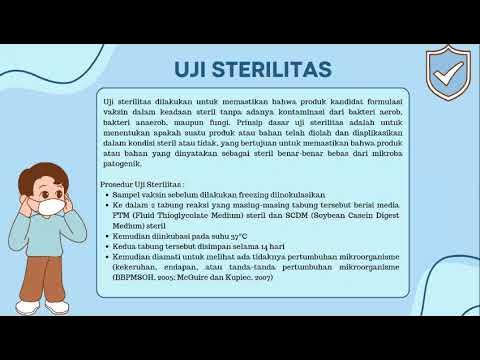Lecure 11 Teknologi Produksi Vaksin
Summary
TLDRThis video provides an in-depth exploration of vaccine development, focusing on different vaccine generations, production methods, and technologies. It covers the definition of vaccines, their components, and the immune response they trigger. The video explains the evolution from traditional vaccines using whole or inactivated pathogens to advanced recombinant and DNA vaccines. It also details the stages of vaccine production, from the cultivation of pathogens to the final recovery and purification of the vaccine. Additionally, it highlights the critical points in vaccine production, including contamination control, fermentation, and quality assurance processes.
Takeaways
- 😀 Vaccines are preparations containing antigenic materials, designed to induce specific and active immunity to prevent diseases triggered by bacteria, toxins, viruses, fungi, or parasites.
- 😀 The primary goal of vaccines is to stimulate the body's immune system without causing illness, using antigenic material like weakened or inactivated pathogens.
- 😀 Immune responses from vaccines are typically specific (involving T cells and B cells) and long-lasting, often leading to the formation of memory cells.
- 😀 Vaccines not only protect against infectious diseases but can also be used to prevent and treat non-communicable diseases and even diseases related to travel (e.g., Hajj pilgrims getting vaccinated against endemic diseases).
- 😀 Vaccine development has evolved through several stages: from the first generation (using live but weakened pathogens), to second-generation vaccines (using recombinant technology or pathogen components), to third-generation DNA vaccines.
- 😀 The first generation of vaccines involves using live pathogens that have been weakened genetically or chemically to eliminate their infectious nature (e.g., yellow fever vaccine, polio vaccine).
- 😀 Second-generation vaccines utilize recombinant DNA technology, often using parts of the pathogen like proteins or toxins to trigger an immune response (e.g., tetanus toxoid vaccine, conjugate vaccines).
- 😀 Recombinant vaccines are created by using recombinant DNA technology to insert parts of a pathogen's genetic material into another organism (e.g., bacteria or yeast), which then produces the antigen for immune response.
- 😀 Third-generation vaccines, such as DNA vaccines, involve directly introducing pathogen DNA into the human or animal body, where it triggers an immune response through protein expression in target cells.
- 😀 Vaccine production involves critical stages like bacterial propagation, sterilization of the medium, fermentation, purification, extraction, and recovery of the product. These stages ensure the vaccine is safe and effective for use.
Q & A
What is the main purpose of a vaccine?
-The main purpose of a vaccine is to induce specific and active immunity in the body against a particular pathogen, such as bacteria, viruses, fungi, or parasites, without causing illness.
What are antigenic materials in vaccines?
-Antigenic materials are components of a pathogen, such as proteins or toxins, that can stimulate an immune response in the body. These materials are included in vaccines to trigger immunity against a specific pathogen.
How does the immune system respond to a vaccine?
-Vaccines stimulate a specific immune response, involving T cells (both helper and cytotoxic) and B cells, leading to the production of memory cells that provide long-term immunity to the pathogen.
What are the different generations of vaccines?
-The three generations of vaccines include: First generation vaccines, which use inactivated or weakened pathogens; Second generation vaccines, which use components of the pathogen such as toxins or membrane materials; and Third generation vaccines, which use recombinant DNA technology or DNA vaccines.
How are first-generation vaccines produced?
-First-generation vaccines are produced by using intact pathogens that are either weakened (live attenuated) or inactivated (killed) through chemical or physical methods, such as heat or chemical treatment.
What is the difference between toxoid vaccines and conjugate vaccines in the second generation?
-Toxoid vaccines contain inactivated toxins from pathogens, while conjugate vaccines combine a weak antigen with a stronger one, such as polysaccharides with proteins, to enhance the immune response.
How is recombinant DNA technology used in vaccine production?
-Recombinant DNA technology is used to produce vaccines by isolating specific genes from pathogens (e.g., dengue virus) and expressing them in a host organism like bacteria or yeast, which then produces the desired antigen to stimulate immunity.
What is a DNA vaccine?
-A DNA vaccine involves inserting the DNA of a pathogen into the body, which then directs the cells to produce antigens that trigger an immune response. This type of vaccine can be administered via injection or other delivery methods such as microneedles or liposomes.
What is the importance of plant-based vaccines?
-Plant-based vaccines are developed by introducing foreign genes into plants, allowing the plants to produce antigens that can be used to immunize individuals. This method provides a cost-effective and alternative approach to traditional vaccine production.
What are the critical stages in vaccine production?
-The critical stages in vaccine production include sterilizing the medium, ensuring optimal fermentation conditions, purification, extraction of metabolites, and recovery of the vaccine product, with careful control to avoid contamination and ensure high-quality production.
Outlines

This section is available to paid users only. Please upgrade to access this part.
Upgrade NowMindmap

This section is available to paid users only. Please upgrade to access this part.
Upgrade NowKeywords

This section is available to paid users only. Please upgrade to access this part.
Upgrade NowHighlights

This section is available to paid users only. Please upgrade to access this part.
Upgrade NowTranscripts

This section is available to paid users only. Please upgrade to access this part.
Upgrade NowBrowse More Related Video

mRNA vaccines, explained

Presentasi Mikrobiologi Farmasi Quality Control (QC) kelompok 2 FA22-2

【ベストセラー】きょうから始めるコロナワクチン解毒17の方法【本要約】

#44 Video Pembelajaran Biologi - Bioteknologi

TEORI BIOTEKNOLOGI FARMASI : NANOBIOTEKNOLOGI (PENGHANTARAN OBAT, VAKSIN) KELOMPOK 7, TEORI 3

How the COVID-19 vaccines were created so quickly - Kaitlyn Sadtler and Elizabeth Wayne
5.0 / 5 (0 votes)